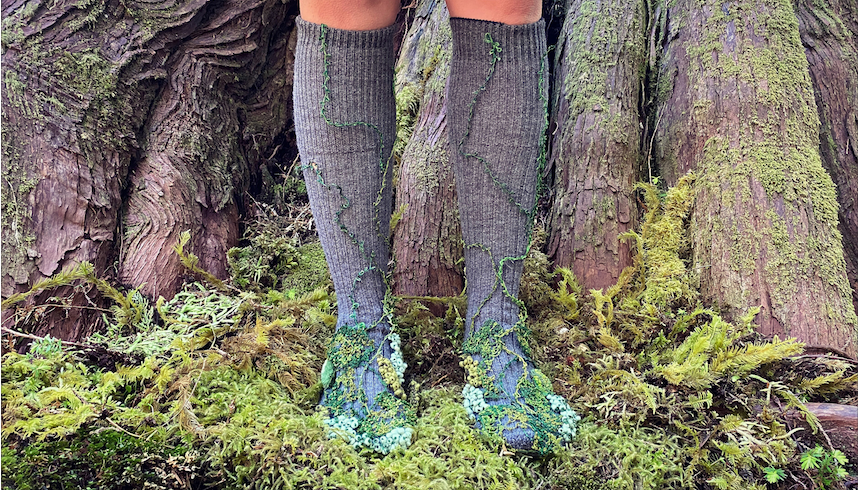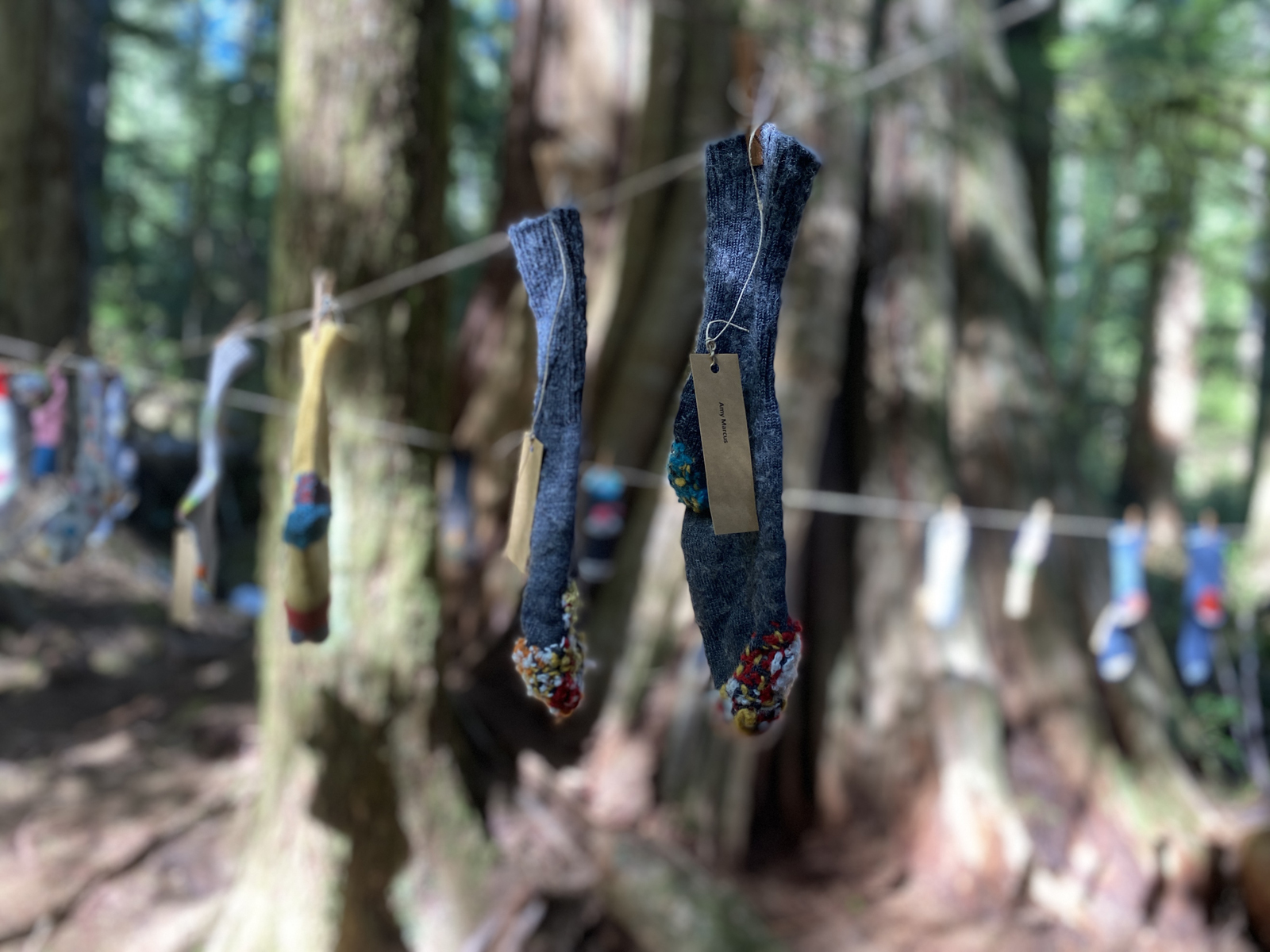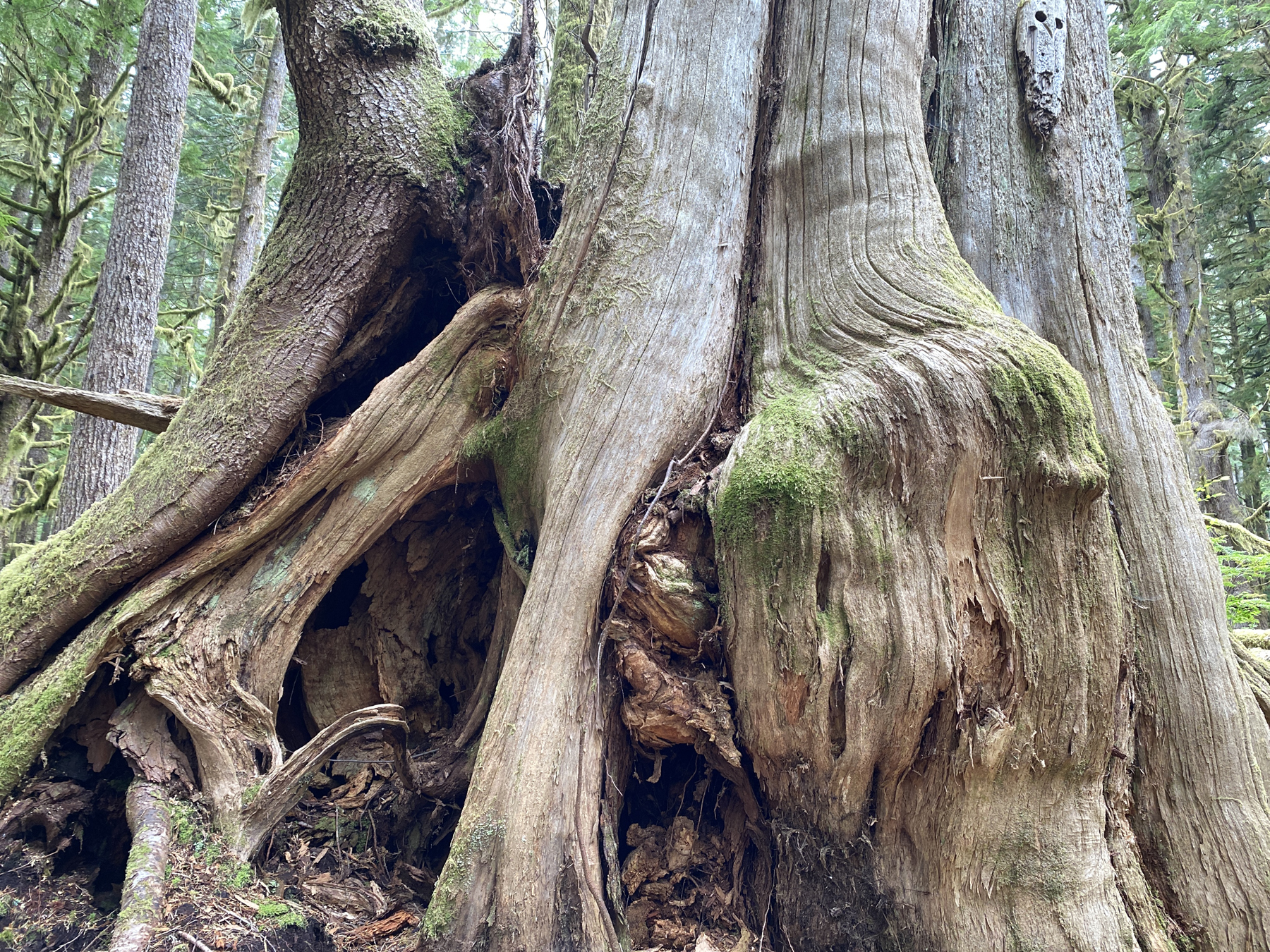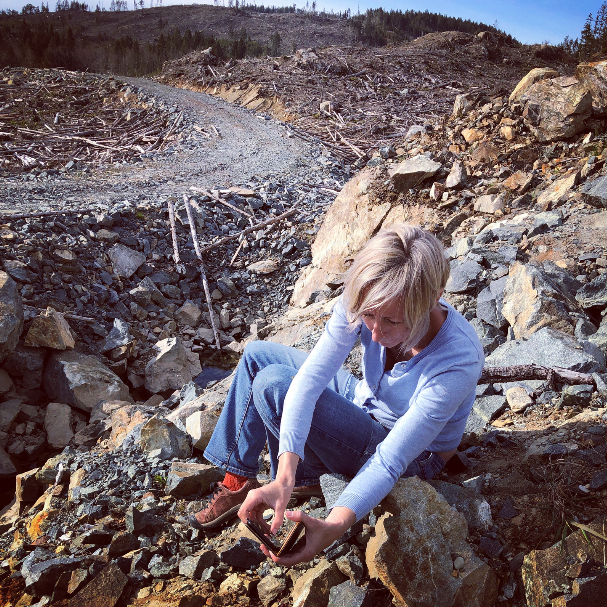
The Ground that Mends, Stop-motion with textiles in the old growth forests of Eden Grove, June 2021
The Mending Ground at Eden Grove
An interview with Connie Michele Morey
Please tell us about yourself, where did you grow up, what is your background?
From an early age, I roamed the woods of the Frontenac County of Ontario, Canada on what was once a vast territory of the Anishinaabe peoples. Our family lived rurally off the land, building, gardening, canning, hunting, fishing, tapping trees and cutting wood. My adopted father was a mason and my mother taught me a deep appreciation of all living things and a wealth of textile experience. My first aesthetic experiences were in the woods, wandering by myself, paying attention and being awestruck by the forest that was my elder and teacher. I was drawn to both the forest and textiles at an early age, but it was not until I was an adult that I realized that my lived white privilege and Scottish and Scandinavian ancestry included the erasure of early Anishinaabe ancestors (paternally Algonquin, and maternally Ojibwe). On my mother’s side Ojibwe ancestors were hatters, moccasin, and coat makers, with abundant textile experience and knowledge of the land. This is the foundation of my Identity and later education and research in textiles, sculpture, performance, eco-ontology, and decolonial studies.
And, where do you live now?
I currently live on the unceded territories of the Lək̓ʷəŋən and W̱SÁNEĆ Peoples on Vancouver Island in British Columbia. Vancouver Island is home to some of the oldest trees on the planet. Travel two and a half hours north-west of Victoria and you will find the contiguous forests of the Fairy Creek and Gordon River Watersheds on unceded Pacheedaht territory and the Caycuse Valley on unceded Dididaht territory. These are the sites of several blockades established by the Rainforest Flying Squad under the guidance of Pacheedaht Elder Bill Jones and Hereditary Chief Victor Peter protesting the threatened logging of the less than 3% of the ancient forests left on Vancouver Island. In these watersheds are the small, protected area of Avatar Grove and the legendary Big Lonely Doug. A short hike past Big Lonely Doug in the Gordon River Watershed is one of the most beautiful ancient places on earth - Eden Grove. Eden Grove is the site of Eden Grove Artist in Residence Program – a grassroots artist residency set up by curator and forest activist Jessie Demers, in alliance with the blockades. It is here that I have carried out my most recent studio project “The Mending Ground” in the ancient forests of Eden Grove as one of the artists participating in the program.

Installation view of The Mending Ground Community Project, Art-socks by Amy Marcus & fifty other makers and menders from across Turtle Island, Eden Grove, June 2021
Tell us about your arts practice.
My studio practice explores the experience of home as ecological interdependence. It asks questions about ecological relationships - the relationships between economics, labour, displacement and belonging to the earth as home. Through site-specific performance and participatory sculptures documented through photography and video, my work explores how colonial approaches to industry and labour are informed by a displaced relationship to the earth and how Industry’s engagement perpetuates further acts of displacement.
I understand you’re currently an artist in residence at Eden Grove on Vancouver Island. Please tell us more about your work there and the place.
Prior to my current residency at Eden Grove, I spent two years traveling to over forty displaced industry and village sites on the east and west coasts of Canada. This studio research led to projects like: Project Homesick (Roof Over My Head), The Breathing Wall, Hearing Voices, Division of Labour, Writing for the Soil, and my current work for The Mending Ground. Visiting these sites increased my awareness of the relationships between the primary resource industry’s focus on “economic growth” and ongoing acts of displacement towards marginalized groups and species that have come to be a pattern for colonial culture in North America.

The Mending Ground Community Project, Art-socks by Christina Morey & fifty other makers and menders from across Turtle Island, Eden Grove, June 2021
What is Mending Ground?
The Mending Ground is a three-part studio project that includes: (1) The Mending Ground Community Project, (2) Harvest and Gather (performances with the trees) and (3) The Ground that Mends (a textile-based stop motion animation exploring the relationship between the body and the earth). The Mending Ground Community Project invited artists, makers, and menders to creatively darn, embroider, stitch &/or bead an 'art- sock' as an offering of gratitude and healing to the earth. The project asked participants to stand with the last remaining Ancient Forests while they continue to provide for us, clean our air, nourish our ecosystems, teach us how to live, breathe, be present and heal. Fifty participants of all ages from across North America responded to the call and their work was exhibited together in the ancient forest at Eden Grove with a one-day pop-up installation on June 1st, just prior to police enforcement on the blockades at the entrance to logging road leading to Eden Grove.
The acts of stitching traditionally reference 'matrilineal' acts of care and healing in mending our relations with materials, each other, other species, and the earth. Darning, stitching, beading, and embroidery are creative skills sets often passed down from mother to daughter that offer a way to honour materials by mending to extend the life of the item, beautify, care and avoid planned obsolescence and material waste. Each art-sock made by hand is a tender act of standing with old growth for many menders and makers who could not travel to the blockades.
 Harvest, Performance with hand embroidered ‘companion species,’ Eden Grove, June 2021
Harvest, Performance with hand embroidered ‘companion species,’ Eden Grove, June 2021
The performances Harvest and Gather engage ritual responses (rather than spectator focused events) of presence and reflection with the trees. Both performances are indebted to Anishinaabe biologist and matriarch Robin Wall Kimmerer's advocacy for The Honourable Harvest, and question what it means to harvest, gather, labour and engage with economics, while looking to the forest as a model for revisioning systemic colonial ideologies of economic growth.
The textile-based stop-motion The Ground that Mends subverts the title The Mending Ground, which focused on human-centered modes of caring for the earth. It acknowledges the role of the sentient ecosystems of the ancient forests as biomes that provide, sustain, and heal in succession. If ecology is about relations, then perhaps human species would benefit from looking to the ontological relations of the ancient forests as a path forward – a way to heal our impoverished approaches to relations with each other, other species, global economics, labour and what we understand as home.
I can imagine it has been a great experience for you making work amongst old growth trees. What are your thoughts about the role artists and the arts can play in protecting trees and forest? Do you feel artists also need to be activists? How can artists make a real difference?
As I stand in the forest performing and documenting work, I am brought back to a childhood experience of gratitude and awe of the forest’s mending ground. In the old growth of Eden Grove, thousand-year-old trees hold space for other species to flourish. Even in their falling, during storms and other natural occurrences, old growth ecosystems provide successive restoration for everything, including those humans that rely on them for their survival, while often denying their right to be.

Artists have such an important role in giving voice to important social issues. Yet the activism that artists offer is uniquely symbiotic. Art transmits experience. Rather than telling the viewer what to think, art can bring the viewer embodied experience, memories of the body of being connected to the earth. This form of embodied experience mediated through art connects on a different level than fact-based evidence. It is knowledge that not just cerebral as art engages the senses, with the body, emotions, and mind, as one. Many contemporary art practices explore important environmental and ecological issues in a way that allows for the complexities of the world to co-exist, while moving the viewer from the inside-out towards the need for action, accountability, and voice. I love when art invites questioning, because I think that through embodied experience and open questioning, personal engagement becomes possible. In this space of connection, we open ourselves to what really matters, memories of the body that remind us of the fundamental need for attachment, to belong and feel connected with the earth as home.
I do not believe that any significant socio-ecological change can occur unless there is an ontological shift in the way we see our relationships with the earth, other species and each other, as one that it intimately interdependent. Once we experience everything as kin, we are less likely to use others as “resources” available for exploitation. Art is sensorial and experiential, and it is through embodied experience that we authenticate these connections.
Old growth forests are pioneer aesthetic environments. They wake up our senses, connect us to the earth in the present, and make us feel alive. Ancient forests not only give us life, but also resuscitate us, connect us to our creative selves, and model a way forward to heal our displaced relationships to with the earth, each other, and ourselves. It is not by accident that so many artists have come together to defend the right for these ancient biomes to exist. Old growth forests are matriarchs of creativity. They embody imaginative abundance, allowing for unique species to connect and growth symbiotically while remaining distinct. My experience of creating in the presence of these sacred trees is akin to the embodied experience of morning sunlight or fresh wet air; it is a coming home to myself-in-the-world.

The Mending Ground studio project is situated at the intersection of art and activism as an act of standing with the last remaining old growth forests of Vancouver Island. The project includes: The Mending Ground Community Project with fifty participants across Turtle Island, as well as performances and a stop-motion video by Connie Michele Morey, in partnership with Eden Grove Artist in Residence Program on unceded Pacheedaht territory.